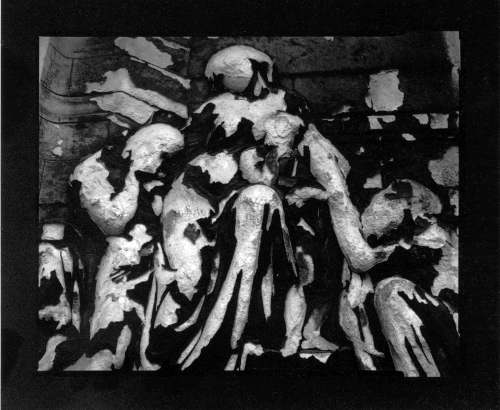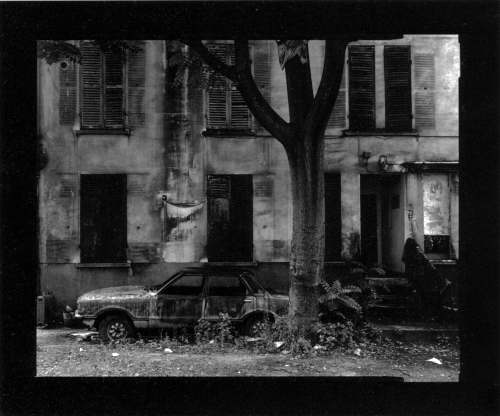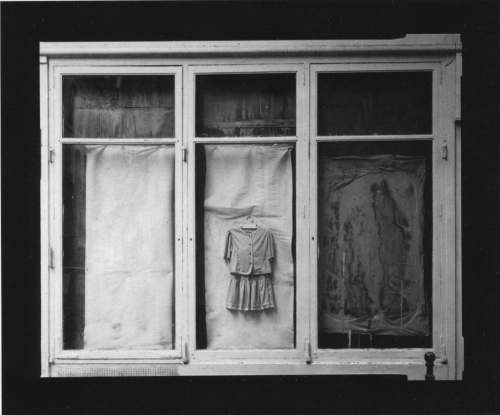12-27 V 1995
(LA VILLE INVISIBLE, PARIS)
The "Greyness" of Endurance
- on photogenic works of Bogdan Konopka.
Small-sized works (10 x 12.5 cm); pictures recorded with the help of a photographic camera: pictures of banal or extraordinary objects, accumulation of facts and associations, dust that has been setting on for years, covers emanating brightly and grey surfaces, shadows the colour of a body and bright spots which may replenish words, traces of the passing time caught in a moment of eternity. Substitutes for endurance, a melancholy ordinariness of endurance... Few contrasts; economical whiteness, attractive blackness, discreet passages between valours, thick, velvet greyness, an emanation of greyness, its shades that differentiate, name and attract apparitions. The photographs of Bogdan Konopka, pictures of interiors and natural landscapes - balanced views, as if composed in their surroundings, as if prepared before the taking of the picture... But it is an illusory feeling. In fact these frames are almost "naked" in their literal meaning: they reveal an unprepared, real image, but it is an image caught with a lens of a camera - with the "eye" of the camera which can see both ways; it catches what can be found in front of it, but it also penetrates the consciousness of the photographer, it looks inside of him.
Those photographs are without people, without any face within the frame or a bright gaze of a person in the portrait - but still they are marked by the presence of man, the presence which is not direct, of course, but which results from the implied meaning, from the saturation of shapes and real images with the aura of non-obviousness - that is with something that can be associated with the notion of spectrum, which is one of the fundamental features of photogenic works and a characteristic element of photogenic creation.1
As E. Morin claims2, the photogenic quality of a picture is a unique combination of significant features of shade, reflection and spectrum, which lets emotional elements, intrinsic for a mental image, to be transmitted onto a picture of photographic reproduction. Spectrum especially expresses the potency of our consciousness and our aspirations. Morin says that "the spectrum contains all the desires of man, and most of all his most subjective and mad desire of immortality. Indeed the spectrum is the most fundamental picture of the human being which precedes man's own consciousness, the picture that may be recognized in a reflection or in the shade, which appears in dreams and hallucinations, in paintings and in sculptures; it is a fetish-like image which is honoured in all beliefs in an afterlife, in all cults and religions".3
Perhaps only in this way the presence of man is justified, the presence of the subject in every work; in a photographic work, for instance in a photographic work, which adds to the "original" (a piece of reality represented) something that is not there-all thanks to its ability to record on sensitive film something that does not generate light, something that is invisible, not obvious, and something that is photogenic
The spectrum "comes from" the living world, it is ascribed to death, although in art it is also a challenge to death. R. Barthes4 calls all photography necrophilic because it is close to death, it records and preserves those states which passed away, which died or moved on. But photography also serves our memory, it is a memory, so it opposes nothingness, destruction or annihilation. We take photographs to be close to them later, to be with them as if they were real people, real objects, etc. For example photographs are used in such a way in spiritism and in occult and magic practices. Perhaps this is why some religions have the fear of photography, the fear of snatching away one's personality, one's secret.
Photography as a means of taming time, searching for the places where there is no death (we are there and we have them), calling the "spirit" or the spectrum of those places, taming the interiors where time has survived, "held his breath", found a place in the layers of light and darkness which grow on year after year, in all the traces of what passed away. Those places are the converging point of the "greyness" of endurance, of being; in the realities of art, in our memories, in the photogenic image of reality.
The photographic works of Konopka may be understood within the limits of such a programme. He certainly shows the desire to record changeability, "stuff" time into solid forms, time which is not renewed, which is dependent on the ordinariness of being, suspended in between black and white. Perhaps this is the source of his obsessive interest in greyness which becomes the building material of an image, which exhausts and links all the qualities the term "photogenic" evokes. Konopka`s older works from the 80s (the series "Reality without time-limit", for example) were made in that style, and he still creates a similar atmosphere in his works (for example the works from the series "Spirit of places").
Poetry is the art of the word evoking unusual images. The photogenic quality is the poetry of the photographic image, an unusual image selected from ordinary reality. The selection is attributed to the individual abilities of a given artist. Just as not every poem is poetry, not every photograph is photogenic, not always is it possible to "catch" photography in the act and introduce something new into it, something that we want to say or to express. Because photogenic quality does not result from the chemical features of the grain of photographic film but from what we put into this kind of art; these are the "invisible qualities of our minds (...) which belong to photography but which photography gives us back (...) It is clairvoyant photography: it shows the invisible". As E. Morin says, it becomes the resultant of the empirical and oneiric approach5.
Every kind of photography shows the play of shades and light - it is both literal and arbitrarily interpreted in the "language" of our culture. Every photography is the reflection of reality, a formally transformed (screen) flat copy of that reality. But not every photograph can add something to this image, almost create it anew, complete it with form which is carried over reality, which does away with it and which raises it higher, which degrades it and sublimates it. What is in question here is the analogon - a picture of reality created on the basis of a real image, but an image that was first shaped in the mind, between sensitivity and creative abilities. It is here where the additional element appears - something that comes into being on the border of reality, something that shines through the background, that is shaped between the whiteness and the blackness, between intentions and their fulfilment, between what is obvious and what is added by the act of will of the artist, in the conflict of emotions, feelings and impressions, in what results from the not obvious world of art. This is also how the photogenic qualities of an image appear, this is the uniqueness of the aura that the photograph generates.
Bogdan Konopka photographs interiors in a very photogenic way - the lumber-rooms presented in his works have been given the status of almost universal sets, sets of objects which are not something concrete and familiar, but which become almost eternal. To paraphrase R. M. Rilke's verse those are the objects which look through us, which pierce us through and know everything about us... And finally, although it may sound conventional, those real interiors are transformations of the not obvious interior, they show poetic sensitivity, they are the afterimage of metaphysical questions. And they are "raised" to the rank of specific places where good spirits (apparitions) protect from the passage of time, protect us like traveling amulets..
The rule of reducing everything to an interior is also used when Konopka photographs open spaces. His images of landscapes, images of streets, piles of used objects, the bodies of houses, groups of trees, water etc. - all are reduced to the limits of "closed" space. These are interiors which express the most characteristic feature of Konopka's work: the desire to record photographically in oneself images of reality, images saved from changeability, images which give shelter in the photogenic "interior" of art.
Andrzej Saj
Translation: Maciej Świerkocki
Notes:
1 See A. Saj: "W kręgu twórczości fotogenicznej, "Format", vol. 8-9,1992
2 E. Morin: Kino i wyobraźnia, Warsaw,1975
3 ibidem
4 R. Barthes
5 E. Morin: op. cit.
Look also: FOTOTAPETA - Bogdan Konopka in Mała Gallery (in Warsaw).
Copyright ©1998 Galeria FF ŁDK, Bogdan Konopka, Andrzej Saj.




